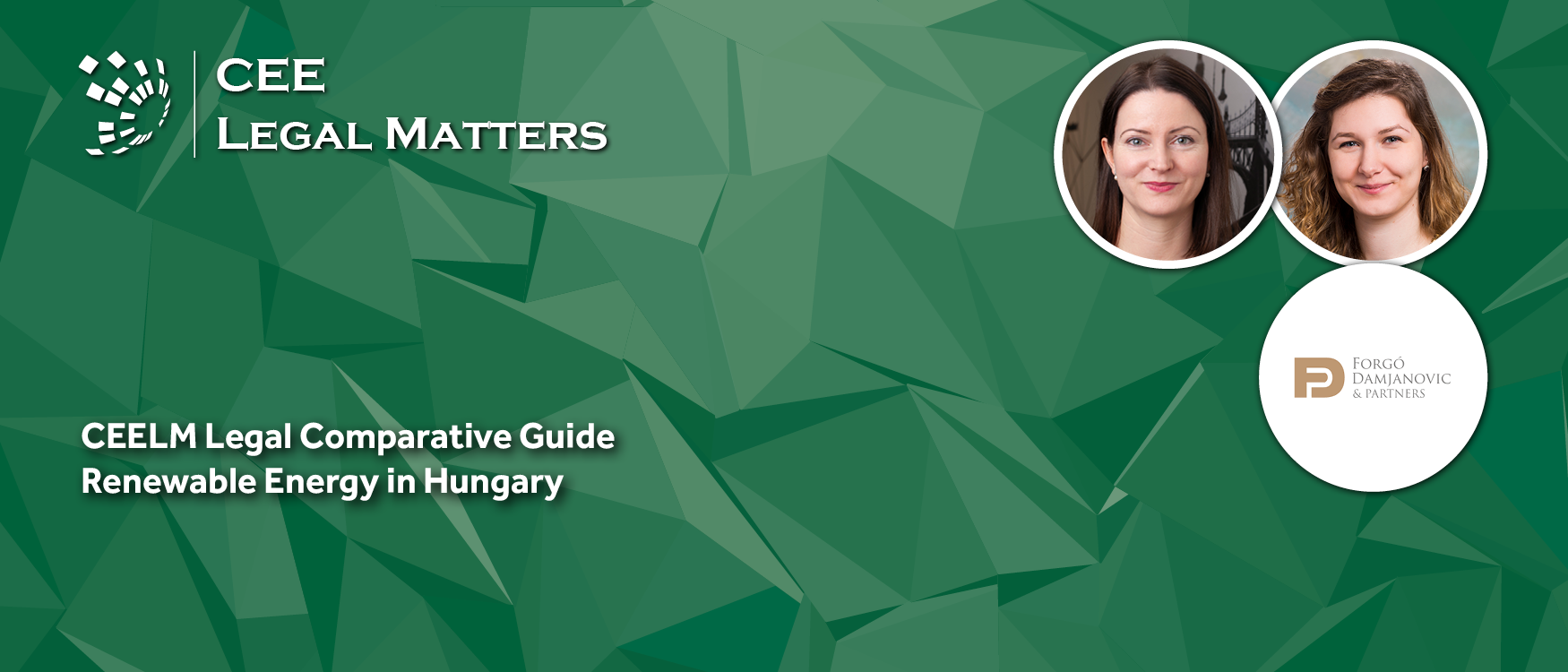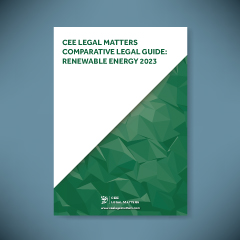Contributed by Forgo Damjanovic & Partners
1. SUMMARY
The Hungarian renewable energy sector has developed recently, mainly focusing on photovoltaic power plants. According to the data publication of the Hungarian transmission systems operator, the installed capacity of the Hungarian solar power plants has exceeded 4,000 megawatts in 2022. There are future projects which have already received access to the transmission grid in an amount of approximately 5,000 megawatts. Therefore, the installed photovoltaic capacity might double within a few years, and the Hungarian target of 6,000 megawatts of total installed solar capacity by 2030 could be reached much earlier.
The Hungarian capacity of wind farms is around 330 megawatts. All of the wind power plants were authorized and constructed before 2016, since then, no new wind power plant has been established in Hungary due to the very restrictive legislation, which makes the construction of wind farms practically impossible.
Due to the rapid growth of the Hungarian renewable energy sector, the electricity system currently faces a capacity deficiency. A national transmission system upgrade is necessary to enable the integration of the electric capacity generated and requested by weather-dependent energy sources.
2. OVERVIEW OF THE COUNTRY’S RENEWABLE ENERGY SECTOR
2.1. Legal Framework
The legal framework of the renewable energy sector is determined by Act LXXXVI of 2007 on the electric energy (Electricity Act), government decrees, decrees, and resolutions issued by the Hungarian Energy and Public Utility Regulatory Authority (HEA) and various regulations (e.g., Commercial Code) of the Hungarian transmission system operator (TSO), MAVIR Zrt.
In Hungary, electricity from renewable energy sources was supported by the mandatory offtake (KAT) support scheme until 31 December 2016. The principle of the KAT support scheme is that the power plants may sell the produced energy in the mandatory offtake based on an annual fixed amount. The fixed tariff is 40,34 HUF/kilowatt hour in 2023. The amount of electricity and the period of the mandatory offtake are determined for each eligible electricity producer. The provisions of participating in the KAT scheme have changed several times in recent years. Currently, the producers in the mandatory offtake system are not allowed to leave the support scheme and sell the produced electricity in the free market.
A new renewable energy support scheme (METAR) was introduced in January 2017. The introduction of the METAR scheme does not interfere with the previously obtained KAT entitlements. The METAR scheme comprises three sub-systems determined by the power plant’s capacity: a feed-in tariff (for plants below 0.5 megawatts), a green premium without tendering (for plants below 1 megawatt) and a green premium granted through tendering procedures for all kinds of renewable power plants.
The principle for the feed-in tariff support system is the same as for the KAT support scheme. In the METAR green premium (without tendering) support system, the producers may sell the electricity generated from renewable sources on the free market at market price, and the producers receive administrative premium support above the market reference price as a surcharge claim (the so-called market premium). The budgets of the feed-in and the green premium (without tendering) systems determined for 2020-2026 were exhausted in 2019; therefore, new entitlements cannot be requested.
However, the METAR green premium tendering procedure is still available for new renewable energy projects. The tenders are technology neutral, with one bidding round and a price-based evaluation. The winners will be granted green premium support at the initial supported price in the winning bid for the period determined in the tender call, but for 20 years at most. The HEA organizes the tenders, and the last tender took place in March 2022. 435 gigawatts hour/year support was requested in the tender.
The regulatory body of the energy sector is HEA, an independent regulatory authority whose responsibility covers licensing, supervision, price regulation, and tariff-and-fee preparatory tasks in the fields of electricity.
The HEA licenses are necessary to establish and operate power plants generating electricity, to operate electricity storage facilities, and to trade electricity.
Different rules and licensing procedures apply to power plants based on their nominal capacity, and a license is not required for power plants with less than 0.5 megawatts capacity. Small power plants with a capacity between 0.5 megawatts and 50 megawatts are subject to a simplified licensing procedure; The HEA issues a combined micro power plant license for constructing the power plant and the electricity generation in a single procedure. Power plants with a capacity of 50 megawatts or more shall obtain a separate license for the establishment of the power plant and a separate license for the operation of the power plant.
The main rules of the grid connection and the capacity allocation are determined in the Electricity Act, and within this framework, the TSO determines the detailed rules. Theoretically, grid connection capacity can be obtained through competitive allocation tender or in an individual procedure, but currently, there is no capacity to apply for. For the details, see Section 3.1.
The environmental impact assessment of a renewable project is required if the project exceeds certain thresholds in terms of the size of the land or the installed capacity and pursuant to a preliminary assessment, the project has a significant impact on the environment. If a project is subject to environmental impact assessment, the activity may only begin after the issuance of the environmental protection permit.
The distribution and transmission tariffs (such as electricity system usage fees, connection fees, and special fees) are subject to regulation and determined for price regulation cycles. The current price regulation cycle started on April 1, 2022, and the framework rules are described in HEA Decree No. 12/2020. (XII. 14.). The fees are calculated and determined by the HEA taking into account the principle of the least cost and the justified costs of the network licensees. When determining the fees, large changes from one year to the next shall be avoided as far as possible.
As renewable energy projects have only started to become widespread in recent years, there are several areas where special legislation has yet to be adopted, including renewable power purchase agreements, electricity storage requirements, and the operation and maintenance of renewable energy projects.
2.2. Domestic Sales and Imports/Exports
In 2021, the share of electricity from renewable energy sources in the gross final electricity consumption was 14.3%, with a 56.5% increase in electricity generated by solar power. The goal is to increase the share of renewable energy sources to at least 21% by 2030.
In recent years, the most dynamic growth appeared in using solar power, renewable district heating and heat pump systems, and biofuels with mandatory blending rates. The expansion of small-scale hydropower capacity is also planned, in addition to maintaining existing hydropower plants.
In the heating and cooling sector, there is great potential for the efficient use of biomass and ambient heat through heat pumps. Only 10-15% of Hungary’s geothermal potential is currently exploited, although geothermal energy can be a competitive alternative to other energy sources. Given the geological conditions of Hungary, the aim is to exploit the geothermal thermal energy potential. In addition, the possibility of the biodegradable fraction of municipal waste for useful heat production should be exploited.
Hungary’s import energy dependence is high. The import dependence rate for all energy sources was 54.3% in 2021. However, Hungary is devoted to eliminating its reliance on imported energy sources and boosting electricity production relying on nuclear and solar energy. The goal is to stabilize the share of energy imports below 20% by 2040.
2.3. Foreign Investment and Participation
Hungary currently has a two-folded FDI regime:
The Act LVII of 2018 on controlling foreign investments violating Hungary’s security interests regulates a national security-type screening in the “classic” strategic sectors, including certain services under the Electricity Act. According to this regime, a ministerial acknowledgment is required if a foreign investor intends to acquire – directly or indirectly – at least 25% of the ownership of a company (or 10% of a public company), falling under the scope of applicability of the relevant regulation.
In May 2020, due to the pandemic, a new regime was introduced: ministerial acknowledgment is required for certain transactions if a foreign (including EU/EEA/Swiss) investor intends to acquire a strategic company (e.g., any Hungarian-based company with an activity in the energy sector) The stake which triggers the notification obligation depends on the investor: in case of non-EU/EEA/Swiss investors the acquisition of 5% (or 3% of a public company) is the threshold, while in case of EU/EEA/Swiss investor, only the acquisition of majority influence falls under the regime. In some instances, an additional condition is that the investment value reaches HUF 350 million (approximately EUR 875,000). This new regime was initially introduced as a temporary one, but it is still in force, currently with reference to the Ukrainian situation.
2.4. Protection of Investment
Hungary is one of the 53 signatories and contracting parties to the Energy Charter Treaty, which provides a multilateral framework for long-term cooperation in the energy sector, including energy trade, transit, and investment. The treaty protects foreign investors in energy, promotes the progressive liberalization of international energy trade, and aims to transfer its provisions to the WTO, thereby giving them global reach.
Hungary is also a party to the Paris Agreement on climate change. Its goal is limiting global warming to well below 2, preferably to 1.5 degrees Celsius. Hungary, among other signatory governments, contributed, before and during the Paris Conference, with a comprehensive national climate action plan to reduce their emissions, additionally committed to publishing action plans every five years, with increasingly ambitious targets in each plan.
The EU also set a target in the Renewable Energy Directive (2018/2001/EU) to cover 32% of the EU’s energy consumption with renewable energy sources by 2030 and to decrease carbon dioxide emissions by 40 % compared to 1990 levels. In compliance with the directive, the Hungarian Parliament adopted the Electricity Act.
In addition, the European Green Deal, signed by all 27 EU Member States, including Hungary, aims to reduce net greenhouse gas emissions (GHG) by at least 55% by 2030, compared to 1990 levels, and turn the EU into the first climate-neutral continent by 2050. Each country was required to draw up its own energy strategy, which Hungary has done.
Additionally, in the framework of its regulatory role, the Parliament passed a new law on climate protection (Act XLIV of 2020) containing the above EU climate objectives along with setting a target for Hungary to achieve a 40% reduction in greenhouse gas emissions compared to 1990 and a share of renewable energy sources in gross final energy consumption at least 21% by 2030.
3. DEVELOPMENT OF RENEWABLE ENERGY PROJECTS
3.1. Granting of Grid Connection Rights
The transmission and distribution networks are available in exchange for the network access fee. In April 2021, a new system for connection to the transmission grid was introduced, whereby producers may connect to the transmission or distribution grid by either participating in a competitive allocation tender or in an individual procedure.
According to this new system, the Hungarian TSO, MAVIR Zrt. regularly determines the free capacity of the transmission grid, and the developers can apply for these free capacities. The first publication was released at the beginning of May 2022, and according to that, there was zero capacity in the system. Therefore, developers can only obtain grid connection through an individual procedure, where the developer has to establish its grid connection. All costs of such developments will be borne by the developer, including the costs of the necessary public network development.
3.2. Ownership by Foreign Companies
According to the Electricity Act and its implementing decree, small power plant licenses may only be granted to companies with a registered seat in Hungary, while licenses for the establishment and operation of power plants with a nominal capacity of 50 megawatts or more may only be granted to limited liability company (korlatolt felelossegu tarsasag) or joint-stock companies (reszvenytarsasag) with a registered seat in Hungary.
Thus, power plants may not be owned directly by foreign companies. However, indirect foreign ownership is generally not restricted. Typically, the power plants are owned and operated by Hungarian project companies, and licenses and authorizations are granted to these project companies. Therefore, foreign investors typically establish project companies or acquire shares in the project companies already holding the necessary authorizations.
HEA’s prior consent is necessary before acquiring, directly or indirectly, shares or voting rights, which represent at least 5% or more of the votes in any license-holder company, except for combined micro power plant license holders (PV plants with a nominal capacity between 0.5 megawatts and 50 megawatts), where the HEA has to be notified only after the acquisition.
3.3. Stages of the Development Process
Before the actual construction of the power plant, the developer has to secure the land on which the power plant will be built and apply for capacity to access the transmission grid.
The power plant can be established on one’s own property or property owned by a third party; however, in the latter case, the owner’s consent is required for the construction.
There are special requirements and preconditions regarding projects which will occupy more than 2 hectares, or the nominal generation capacity of the plant’s unit will reach or exceed 500 megawatts. In these cases, the assessment of the planned project’s environmental effect and preliminary authorization by the HEA is necessary. The preliminary authorization is granted for three years and might be extended for additional three years. In the preliminary authorization, HEA defines the technical requirements for the power plant to ensure the functionality of the electricity system without interruptions and the security of operation and electricity supply.
For power plants with a nominal capacity below 500 megawatts but above 0.5 megawatts, a combined micropower license or a license for establishing the power plant is necessary. The HEA issues these licenses for an administrative service fee, the amount of which depends on the nominal capacity of the power plant (approximately between EUR 1,250 and EUR 5,000). Both licenses are granted for a definite period with a possibility of extension. Based on a combined micro power plant license, the developer is authorized to establish and operate the power plant and also to sell the self-produced electricity. In the case of a power plant above 50 megawatts nominal capacity, the license for the establishment authorizes the developer only for the construction of the plant, and a separate license is required for permanent electricity generation.
To secure the power plant’s access to the transmission grid, the developer has to apply for capacity with the TSO through the competitive allocation tender (if there will be any capacity to allocate) or in an individual procedure. In both cases, the developer must provide financial security in the amount of 900,000 HUF/megavolt amperes (approximately 2,250 EUR/megavolt amperes). Once the grid capacity is secured, the developer enters into a grid connection agreement with the local DSO. The agreement might contain provisions for the public network intervention to connect the power plant to the grid. The agreement is typically concluded for an indefinite period.
If these licenses/authorizations are in place, the developer may apply for the building permits, separately for the power plant and the cable connection required to connect the power plant to the respective substation. These permits are typically valid for two years and might be extended for an additional two-year period. The permits authorize the developer to establish the power plant and the production cable on the given property in line with the submitted technical documentation. The building authority issues these permits after consultation with expert authorities such as environmental or disaster management authorities. The building authority and the expert authorities may determine special conditions which must be met during the construction work.
3.4. Obligatory State/Public Participation
In Hungary, there is no mandatory participation for the state or any other public bodies in renewable energy projects or their development. Nevertheless, through MVM Group (the state-owned group of electricity companies), the Hungarian state indirectly participates in renewable energy projects: MVM has a solar power capacity of approximately 200 megawatts, and they are continuously expanding their capacity from year to year. MVM also owns five hydroelectric power plants, including the two largest Hungarian ones located at Tiszalok and Kiskore, with a nominal capacity of 41 megawatts.
There are two main taxes that specifically burden the electricity producers in Hungary: the income tax of energy suppliers (Robin Hood tax) and the extra-profit tax.
The Robin Hood tax is an income tax payable by energy suppliers and public utility suppliers, including electricity generation license holders and electricity trading license holders (but excluding, e.g., renewable energy producers who participate in the KAT or METAR support schemes). The tax base is the pre-tax profit modified with certain increasing and decreasing items. The tax rate is 31%.
In June 2022, another special, so-called “extra profit tax” was introduced, payable by renewable energy producers who are entitled to participate in the KAT or METAR support schemes but leave or fail to enter the respective support scheme in 2022 or 2023. The tax base is the difference between the hypothetical revenue that the producer would have generated by selling the electricity under the KAT or METAR support scheme and the revenue generated on the market. The specific tax rate is 65%.
3.5. Risks to be Considered
Currently, the most significant risk related to developing renewable energy projects is the lack of grid capacity. See Section 3.1.
In addition, securing the land required for the project may also be problematic in the case of lands classified as agricultural land. According to the applicable legislation, agricultural lands cannot be acquired or used by companies in Hungary, which means that the ownership of the land can only be secured following the construction of the power plant and the reclassification of the land. As a result of this situation, in these cases, the close cooperation of the developer and the private individual owners is required throughout the development phase, which has its own pitfalls.
4. RENEWABLE ENERGY CONSTRUCTION AND PRODUCTION
4.1. RTB Status
Generally, a Hungarian renewable energy project can be considered “Ready-to-built” if it has the following authorizations: (i) ownership or other right securing the use of the land;(ii) combined micro power license for power plants with a nominal capacity between 0.5 megawatts and 50 megawatts or a license for the establishment of the power plant above 50 megawatts nominal capacity;(iii) building permit for the power plant;(iv) separate building permit for the production cables, including transformer station and switching station;(v) grid connection agreement.
4.2. Construction of Renewable Energy Projects
The power plant project has to be constructed in line with the provisions of the building permits and the HEA licenses. Both authorizations contain a timeframe for constructing the power plant, which the developer has to meet. If the developer fails to complete the plant in the given timeframe, the building permits will expire, and the HEA will revoke the HEA license. Constructions are typically carried out within the framework of turnkey EPC agreements.
After the construction of the power plant, a commissioning procedure is conducted, and a so-called occupancy permit has to be acquired for the permanent commercial operation of the plant. The building authority grants the occupancy permit if the construction work was carried out in accordance with the building permit and the related documentation, the plant is in a condition suitable for its safe use, and the consent of the relevant operators of public utilities is given.
If the plant is not established in accordance with the specifics determined in the building permits, instead of an occupancy permit, a continuation permit must be requested from the building authority. In this case, even if the building authority grants the continuation permit, a fine will be imposed simultaneously.
The project owner also has a notification obligation toward the HEA and the TSO regarding the proposed date for the commencement of commercial operations, the completion of commissioning, and the actual commencement of commercial operations.
4.3. Granting of Renewable Energy Production Licenses
Please see Section 2.1. for the main legislation for obtaining renewable energy production licenses.
An operating license is required for the operation and electricity generation of power plants with a nominal capacity above 50 megawatts. The HEA issues the license for a definite period with the possibility of an extension. In the case of power plants with a nominal capacity between 0.5 megawatts and 50 megawatts, the combined micro power plant license obtained before the construction of the plant also covers electricity generation. These licenses authorize the producers to sell self-produced electricity.
The terms and conditions of the operation are determined in the operating license. In the event of a breach of any of these terms, the HEA may issue a written notice to comply with the obligations and/or impose fines. If the license holder fails to remedy the infringement, the HEA may amend or revoke the license. The revocation of the license is obligatory in some cases, e.g., if the electrical installation is operated in a manner that seriously endangers the electricity supply, human life, health, operation, property safety, or the environment.
4.4. Renewable Energy Production by Foreign Investors
See Section 3.2.
4.5. Operation and Maintenance of Renewable Energy Projects
There are no specific regulations on the operation and maintenance of renewable energy projects. However, the expert authorities might determine special conditions in the occupancy permit for the operation of the power plant with regards to environment, nature or soil protection rules or disaster management requirements, etc.
In most cases, the operation and maintenance are performed by third-party contractors in accordance with the terms of the parties’ agreement.
4.6. Decommissioning Process
There is no specific regime in Hungary in relation to the decommissioning of renewable energy projects, disposal of equipment, or recovery of fields. The reason for the lack of legislation might be that the Hungarian renewable energy market has just started growing, so probably no real need has arisen so far concerning the decommissioning of these renewable energy projects.
Nevertheless, the provisions of the WEE Directive (2012/19 Directive of the European Parliament and the Council on waste electrical and electronic equipment) have already been implemented, mainly by Government Decree No. 197/2014. On waste management activities related to electrical and electronic equipment. This government decree does not explicitly regulate the decommissioning process of renewable energy projects, but with certain limitations, it can be applied to decommissioning power plants.
4.7. Risks to be Considered
The most significant factor holding back developers of renewable electricity projects might be the rapid and often unpredictable changes in the regulatory environment. In the past years, significant changes were introduced concerning the grid connection procedure, resulting in zero grid connection capacity. New taxes have been levied on the energy generator, and the rules of the support schemes and the balancing system are also changing continuously, which might require the investors to reconsider their business operations from time to time.
5. BALANCING OF RENEWABLE ENERGY PROJECTS, STORAGE, SALES
5.1. Balancing of Renewable Energy Projects
The Hungarian regulatory framework for balancing renewable energy projects is in line with the 2017/2195 EU Commission Regulation on establishing a guideline on electricity balancing. The framework rules for balancing are determined in the Electricity Act and in its Implementing Decree, while the detailed rules are specified in the Business Rules (Kereskedelmi Szabalyzat) of the Hungarian TSO.
The Hungarian TSO’s responsibilities include ensuring that the electricity system functions smoothly and without interruptions, as well as balancing the electricity system, and also the operation, maintenance, and improvement of the transmission network. To fulfill these obligations, the Hungarian TSO operates the networked meter-balancing system (balancing circles) and makes arrangements for settlement with the balancing circle accounts.
Each electricity producer has to join a balancing circle. In every balancing circle, there is one member, the balancing circle manager, responsible for providing the required schedules and ensuring that the quarter-hourly balance of their producers and consumers is zero.
The goal of this system is to ensure that the amount of electricity fed into the balancing circle and fed out of the balancing circle is the same in every settlement time unit. In case there is a deviance from the schedule (either positive or negative), the TSO charges the cost of the balancing energy supply to the balancing circle manager.
5.2. Storage
There is no specific electricity storage regulatory regime in Hungary, however, the concept was introduced in the Electricity Act in 2016: electricity storage activity is subject to a licensing procedure in accordance with the provisions applicable to power plants.
As the weather-dependent renewable energy projects prove to be a challenge for the TSO in terms of maintaining the balance, the TSO (in line with the authorization of the Electricity Act) amended its Operational Code in 2022 and implemented a requirement for weather-dependent power plants to have a storage unit with at least a capacity of 30% of the nominal capacity of the power plant. This requirement has been suspended due to the Ukrainian situation.
5.3. Sales
Renewable energy producers are entitled to sell the self-produced electricity in possession of their combined micro power plant license and operating license issued by HEA. Other market players have to apply for an electricity trade license at HEA.
The license holders are obliged to offer their available generation capacity to ensure the system-level services and the distribution flexibility services required by the electricity supply regulations.
The electricity producers participating in one of the subsidy schemes (either KAT or METAR) are only entitled to sell the produced electricity in accordance with the provisions of the subsidy scheme. Producers who do not participate in the subsidy schemes may sell their generated electricity on the free electricity market. The sale of the generated electricity may be carried out either directly on the Hungarian Power Exchange (HUPX), which is the organized Hungarian power market or through market-based sales contracts or power purchase agreements.
PPAs are subject to the general legislation of the energy sector and the applicable industrial codes of the TSO, but there are no specific legal restrictions on the conclusion of power purchase agreements between renewable energy producers and electricity traders as off-takers, so the terms and conditions of such agreements can be freely determined by the parties. With respect to corporate power purchase agreements, there are some regulatory provisions to comply with, but the terms and conditions are mainly also subject to the agreement of the parties.
6. ROOFTOP, OFFSHORE, FLOATING, AND AGRICULTURAL RENEWABLE ENERGY PROJECTS
6.1. Offshore Wind and Floating Photovoltaic Projects
N/A
6.2. Rooftop Photovoltaic Projects
In Hungary, rooftop photovoltaic projects are mainly widespread among households and companies to cover their own electrical needs.
These projects are so-called household power plants, which are basically micro power plants connected to the low-voltage system with an interconnection capacity of less than 50 kilovolt amps at a connection point. The general rule regarding this kind of power plant is that the produced electricity shall be accepted and bought by the electricity trader or universal service provider upon the producer’s request. However, due to network capacity issues, Government Decree No. 413/2022 (XI.26.) temporarily suspended the possibility of feeding the electricity generated by household power plants into the public network and only those household power plants may be installed which produce electricity solely for their own electricity consumption. This restriction does not concern those household power plants which were implemented based on connection requests submitted before October 31, 2022. According to the latest news, the review of this temporary suspension is in progress, but the development of the necessary network capacities takes time.
6.3. Agrivoltaic Projects
No information is publicly available in Hungary on implemented agrivoltaic projects. However, an amendment of Act CXXIX of 2007 on the protection of agricultural land foresees future agrivoltaic projects as it enables the establishment and operation of a power plant that produces electricity using solar energy in accordance with the agrivoltaic system on agricultural land if it does not prevent the utilization of the area below the plant as agricultural land. The act also stipulates that the detailed rules will be determined in a government decree, but this legislation is yet to be issued.
7. TRADING OF GREEN CERTIFICATES/CERTIFICATES OF ORIGIN
7.1. Certification
The Hungarian guarantees of origin (GO) system has been operated by the HEA since January 1, 2014. GOs are tradeable electronic certificates that prove to the final customer that a certain share of the electricity was produced from renewable energy sources.
GOs are issued in an electronic registry by the HEA upon application submitted by either the electricity producer or the account holder authorized by the electricity producer. To register into this electronic registry and open an account, the electricity producer has to enter into an agreement with HEA.
GOs are registered after production, so the trading is disconnected from the physical electricity products; it is performed retrospectively.
On February 1, 2022, the HEA joined the European Energy Certificate System (EECS), which means that Hungarian GOs may now enter the international market and foreign GOs received within the EECS are recognized in Hungary.
7.2. Trading
The Hungarian GO market was launched in July 2022. It is an organized, auction-based market operated by HUPX Zrt. HUPX maintains a registry of tradable products that are listed either in the Associations of Issuing Bodies or the HUPX register and offers financial clearing and settlement services to ensure reliable trading processes.
The HUPX GO market started with the single-seller model (MAVIR, the Hungarian TSO), and the multiple-seller model was only launched later in September 2022. According to HEA publications, a total of nearly 1,073 gigawatts hour of domestic and 10 gigawatts hour of foreign GOs were sold for around EUR 3.53 million at the September 2022 auction of HUPX.





